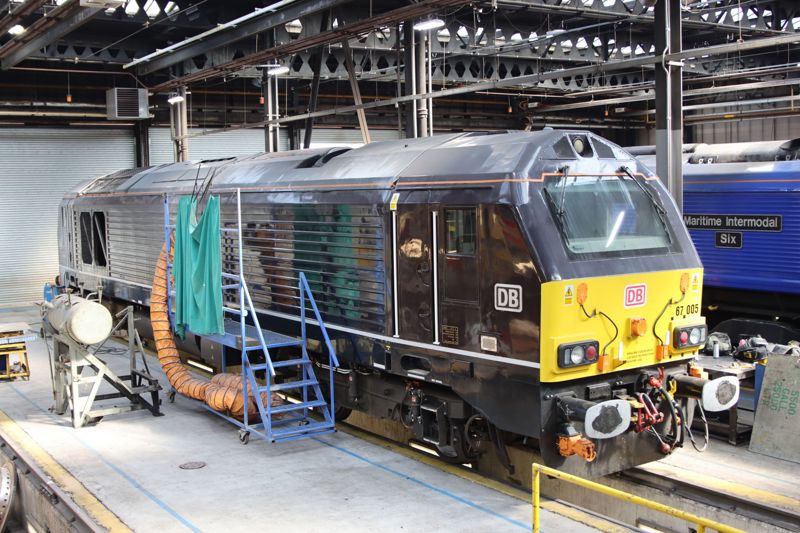
The Royal Household announced this week it would decommission the Royal Train. The dedicated fleet of Mk 2 and Mk 3 carriages will stop being used by March 31 2027.

The Royal Household announced this week it would decommission the Royal Train. The dedicated fleet of Mk 2 and Mk 3 carriages will stop being used by March 31 2027.
The decision ends more than 180 years of train operators having at least a dedicated carriage to carry members of the Royal Family.
Back in 2003 RAIL was given a unique glimpse behind the scenes at Wolverton, the home of the train.
--
The Royal Train has a strange effect on people visiting it for the first time. Even the clumsiest seem to walk a little taller and become a little more graceful. It’s as if the train’s air of hushed dignity somehow nibs off on to them.
It’s a train that blows away preconceptions ofroyalty travelling in a ‘palace on wheels’ - but when you look closer at the workmanship, it seems very much suited for a Queen. It’s a paradox, and, in keeping with that mismatch between expectations and reality, it does feel very appropriate. It’s far from the Formica and cheap carpets reported elsewhere, but I was so surprised at how understated the current Royal Train is that I went to the NRM in York to see if there ever were these railway ‘palaces’ of legend.
I wasn’t disappointed when I was granted extremely rare access to King Edward VII's 1903 coach, built by the London & North Western Railway. There is beautiful wooden panelling everywhere, and all sorts of exquisite detail - even the fan blades are custom-made. The carpet is lush, the chairs covered in the best green leather and the tables intricately veneered. It’s the only carriage I’ve ever taken my shoes offto go inside. It is absolutely gorgeous.
And yet the feel of the coach is exacdy the same as the current train. I can’t explain why, but both are very special. Perhaps it’s simply that such very important people used the coaches. It doesn’t matter: the Royal Train is a national institution and a moving exhibit of the railway at its very best. Access is extremely restricted so it was with real anticipation that I set off to Wolverton where the coaches are maintained. The future of the train is now secure for a couple of years, but it took a remarkable 12 months to prove its value.
The Golden Jubilee
When historians look back on the 2002 Golden Jubilee and examine the Royal Family’s year, they’ll record that for all the dramatic changes in the preceding half-century, a spectacular tour demonstrated the huge affection many feel for the monarch. They’ll point to the huge crowdsthat greeted her wherevershe went and the marvellous concert in London that marked the climax of the e celebrations.
What they probably won’t record are the hugely complex logistics of the programme, or the head-scratching by Her Majesty’s transport advisers at the end of the year, because at the beginning of 2002, the most visible and cherished mode of Royal transport was under threat.
The Royal Train, argued Edward Leigh, then head of the House of Commons Public Accounts Committee, was a waste of money as the fleet of helicopters and aircraft could transport the Royals far more quickly and were far cheaper. Mr Leigh even, reportedly, suggested a Royal coach could be added to service trainsto cut costs: surely, as John McEnroe might say, this man could not be serious - not on today’s multiple unit railway.
By the end of 2002, opinions, it seems fair to say, of the relevance of the Royal Train were being rapidly revised. I’d like to think they came as flashing lightbulb-type revelations to some of those who called for the train’s scrapping - “Did you see the people who came to see the train?”
“It’s saved the security teams having to ‘sanitise’ a hotel and the area around it, don’t you think?” And last, but not least: “And we didn’t even have to worry about whether HerMajesty liked the decor or not.”
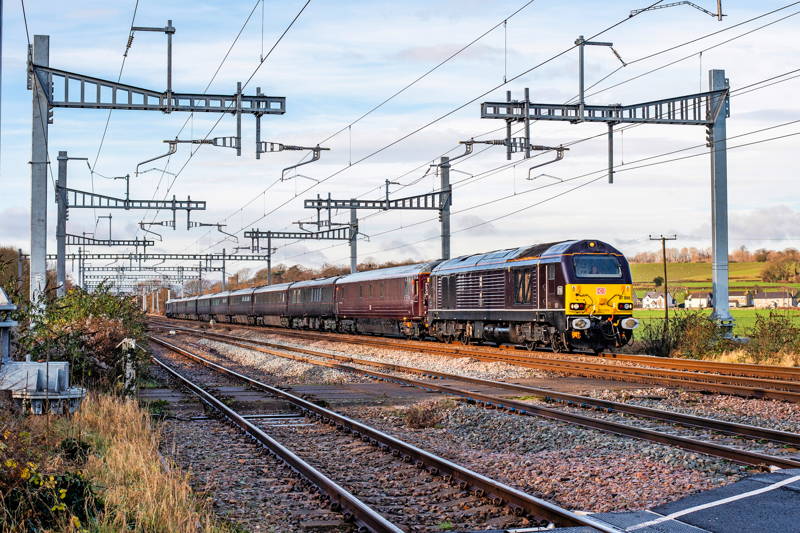
I’m sure, I hasten to add before I am summoned to the lower for an involuntary ‘haircut’, that I don’t believe the discussions really went like drat. It’s clear, though, that the Public Accounts Committee overlooked - and possibly the palace’s transport people did too - that the Royal Train is easily the most visible way of transporting the head ofs tate securely. And during the Golden Jubilee tour, everywhere the Royal Train went were crowds at the lineside hoping for a glimpse of the Queen - in Scodand, the South West, the Midlands and most memorably of all in North Wales, where 6233 Duchess of Sutherland became the first steam locomotive to haul the train for 35 years.
The Royal Train undertook eight extended trips covering 7,135 miles without once running late or failing. Throughout, the Queen was in a secure extension of her household that left the security people with rather less than usual to do. It seems the many advantages of using the Royal Train have been rediscovered by those in charge - and the recent agreement of a two-year extension to its use is testament to a new-found confidence in it, as is talk of a 125mph replacement train.
The current train
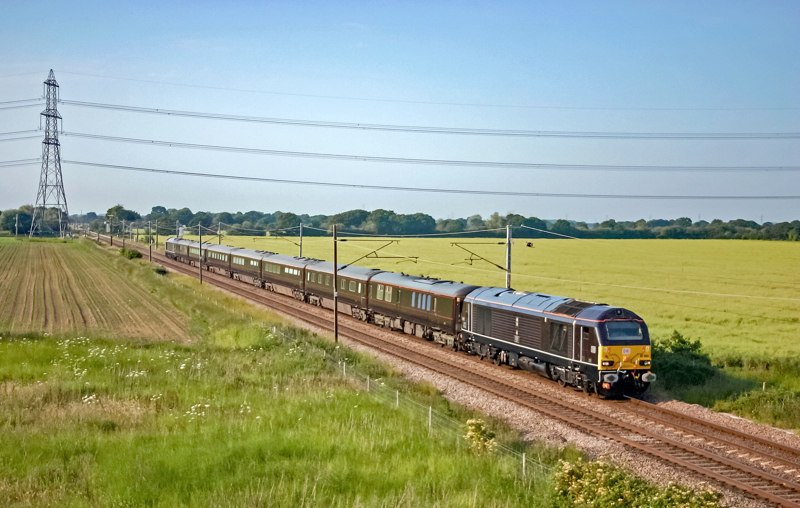 The current train is typically formed of nine Mk 2 and 3 coaches, along with two Class 47s (based at Crewe), and is maintained by Alstom atWolverton, near Milton Keynes. It’s owned by Network Rail and operated by EWS. Rail Gourmet handles catering. Power is provided by a diesel generator in one of the Mk 2 service vehicles as the train’s electric train supply index is higher than the Class 47s can provide.
The current train is typically formed of nine Mk 2 and 3 coaches, along with two Class 47s (based at Crewe), and is maintained by Alstom atWolverton, near Milton Keynes. It’s owned by Network Rail and operated by EWS. Rail Gourmet handles catering. Power is provided by a diesel generator in one of the Mk 2 service vehicles as the train’s electric train supply index is higher than the Class 47s can provide.
It also ensures the current is ‘clean’ and not subject to any fluctuations when the train is running. At a glance, security at Wolverton doesn’t seem much tighter than other depots but after signing in, I’m politely told not to go anywhere while Chris Hillyard, the train’s foreman, comes to greet me.
He’s a local, bom in nearby Roade and has worked in Wolverton since becoming an apprentice for British Rail in 1973. He speaks with a soft but dignified Northamptonshire burr that fits his job absolutely perfectly. There’s no trace ofsnobbery or affectation from his important - and prestigious - position. His gestures show he’s a man both proud of the vehicles in his care and conscious of the place they occupy in the national psyche.
He’s worked on the Royal Train for 26 years - people tend to stay involved with it for a long time (the chief steward has worked on it for 30 years). He doesn’t waste gestures like Peter Snow, but at certain points during my visit, he seems to physically swell with pride. And there’s absolutely no doubt in my mind that he - and all the staff who work on the train - have every right to do so. The fundamental principle underlying the Royal Train is that it’s an extension ofthe Royal household - the best analogy is that of how a caravan is, effectively, a moving part of the owner’s home.
It’s a place where the Royals (known as ‘principals’ by the Royal Train team) can relax and unwind. Very often, Royal visits are busy affairs, with many appointments in a single day - and that means ‘down time’ is very important, as it would be for anyone. The cardinal rule is that the principals are not bothered by anyone unless they want to he. And this can prove tricky if problems occur on the journey.
“One of the first attributes a Royal Train member must have,” says Chris, “is invisibility.” That’s quite a neat trick if you can manage it. On most journeys, there are four staff from Wolverton, plus Chris, two stewards, a chef and EWSR’s Royal Train Officer with a Network Rail representative. This is in addition to the BTP and Royal Household staff who look after the Royal Family member. It must impose a burden on the likes of Chris, who admits he tends to organise his life around the train’s schedule.
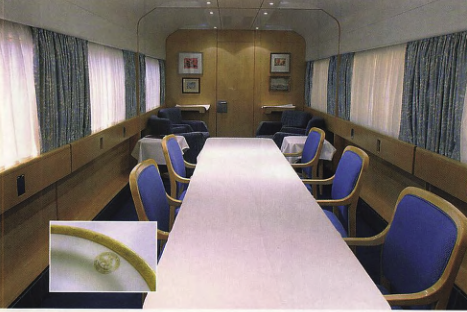
“It’s a pressured job - eased by having good, trustworthy people around you,” he says. It’s another rule that wherever possible, the Royal Train should not disrupt service trains, and being restricted to 95mph, this can pose pathing problems on high-speed lines such as the East Coast. It is, ultimately, this limited speed that is the main limitation on the train’s use, though thw Mk 3 coaches are cleared for 125mph running, and a Class 67 could haul it at that speed.
The workshop
Chris walks our party into a purpose-built workshop deep in the huge site at Wolverton and, for an instant, I have a moment of awe combined with utter disbelief: am I really here about to see the Queen’s train? I’m sure it wasn’t just myself - our work experience student was by me and his face betrayed the same thought. After that brief moment, I looked around to gain some first impressions.
The workshop’s scrupulously clean - even more so than Bombardier’s spectacular Central Rivers depot - and well lit. There’s also a wonderfully clean, warm smell to the place, a mixture of oil, wax polish and varnish that’s like a showroom for luxury cars. It’s a delightfully relaxing aroma that seems to sharpen the senses - it beats scented candles any day ofthe week!
Dominating the workshop are the royal claret and greyfriars grey coaches of the train - and they really are something else. Only the slight ripples of the hodyside affect the mirror-like surface. I’ve seen plenty of brand-new trains, but never any with a paint finish as fine as this. The livery, chosen by the Royals, takes the Mk 3 coaches to a new level.
They look imposing and dignified, and retain that wonderful sense of purpose the design possesses. They’ve always been good lookers, hut the Royal coaches are magnificent. This is a very special place indeed.
Maintenance
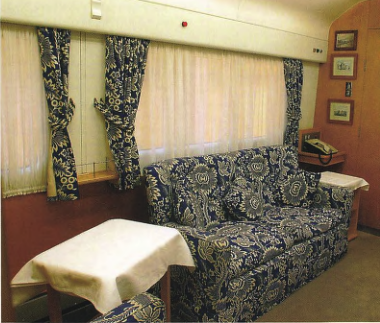
Before Chris takes me round the Royal Train, we meet Alstom’s sales director, renovation, John Tookey in Chris’s office. It’s a veritable treasure trove, with a cabinet full of trinkets from previous trains. The walls arc covered in pictures of staff who used to work on it, of journeys the train has made, and there’s even a signed picture of Hillary Clinton, one of the head of states' wives who used the train during the G8 summit at Birmingham in 1998.
John’s almost as proud of the train as Chris. And while Chris explains the maintenance, John explains how the different parties involved work together: “It’s in all our interests to interact closely. Simply - it doesn’t work if you don’t. There’s a tremendous pride from the whole ofAlstom.”
Despite being formed of Mk 2 and Mk 3 coaches, the maintenance regime differs from that of, say, Virgin West Coast. Though in BR days, they received attention at the same intervals as service vehicles, the fact is they receive far less use - there’s no day-in, day-out hammering up and down the West CoastMain Line for these coaches. So the regime has evolved over the years to reflect the different use.
A good example is that of bogie overhauls. A West Coast Mk 3 can expect to receive bogie overhauls every six years, but those for the Royal Train are extended to around nine years. The maintenance team consists of four tradesmen, one semi-skilled member of staff and two part-time employees who look after the train’s interior presentation. As Chris says, every role is absolutely vital - but the most visible is the interior presentation.
In BR days, trimmers always handled it, but this has changed since privatisation with the contraction of the facilities at Wolverton. All staff require security clearances from the Department for Transport before being allowed to work on the train, and though EWS doesn’t dedicate drivers to the train, it’s widely appreciated the same faces tend appear in the Class 47s’ cabs.
A travelling fitter goes with the train on every journey to handle any unexpected failures - but these are extremely rare, and one unexpected consequence ofprivatisation has been the training of Royal Train staff as shunters.
Just after privatisation, it was discovered the train could incur up to a whole shift’s expenses to hire a shunter from one of the train operating companies - even if all was needed was to ‘hook off the locomotive and run it round the train - so to save costs, some of the staff have been trained.
Typically, there are two vehicles down for maintenance at any time, allowing a train to be formed at short notice if needed. There are contingency plans, but Chris can’t say much as he could reveal some secrets. He might not be able to say what those plans are, but a good example ofthis flexibility happened for Princess Diana’s funeral in 1997. The two Class 47s were being repainted, and coaches were having air conditioning modules replaced as the train was not due to be used for some time.
Nevertheless, within five days, a train had been assembled and the locomotives painted to haul the funeral train to Long Buckby. By any standards, it was a remarkable effort and one that demonstrates the commitment and flexibility of a remarkable team.
Most people, I guess, would expect the train to be repainted at frequent intervals, but it has only received one since it was built. The finish does receive frequent attention, however. When it starts looking tired, the varnish is flatted down and new coats applied. One of the service vehicles was receiving this kind of attention during my visit.
Between revarnishing, the coaches receive healthy doses of wax polishing, though there’s clearly rather more to cover than on the fleet of Royal Daimlers and Rolls Royces.
Inside the train
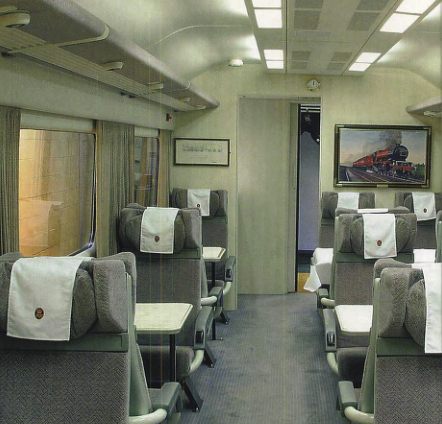
Before we climb the ladder into the first coach, Chris gives a security brief- serious in content, but lighthearted in execution - explainingwhat I can and can’t write about, lop of his list are the Royal bedrooms and the Queen and Duke of Edinburgh’s private quarters.
This is mainly a matter of privacy, and given how little I’d like my bedroom to appear in a magazine, it’s understandable and I’m happy to go along with it. The other item on his list is security'.
It is reasonable to assume that parts at least of the train are armoured and fitted with bullet-proofglass, but he can’t confirm this and won’t say where any security measures are located. He also asks that we don’t identify everything that’s in each vehicle, again for security reasons.
On a journey, the train is split into three sections: operations, where Chris and the railway staff manage the train, Senior Household - Private Secretaries, Equerries and Ladies in Waiting, and Principal - the Royals’ private quarters, though some of these may be in the same vehicles. Without further ado, Chris points us to a ladder next to a door on a Mk 3 saloon.
Inside it looks - in layout - like a Mk 3 ‘sleeper’, with a corridor down the side, but there’s this bizarre sense of being in somebody’s hallway. I get the impression Chris has thought long and hard about this tour, because the first room he takes us in - just for a peek round the doorway - is what he terms ‘a principal’s bedroom’. If he wanted to hit me for a reaction, he couldn’t have chosen his time and place better - it’s one of the most outstandingly surreal experiences of my life.
I had a weird feeling like Alice’s shrinking in Through the Looking Glass combined with admiration for the cunning way the bedroom is squeezed into the Mk 3 bodyshell. It is, undoubtedly, a strange sensation to realise members of the Royal Family sleep here when they use the train. I’m sure part of this is a kind of remote controlled ‘starstruckness’, but there’s also an element of unease - I do feel rather like I’d have invaded their privacy if I went further into the room. There’s not a great deal I’m allowed to say about it, but the room is light, and there are paintings from the royal art collection on the walls. It’s definitely not the grandiose bed chamber some might expect.
Next door is a Private Secretary’s quarters, and we’re allowed full access here. The first thing that struck me, in a Carol Smillie Changing Rooms kind of moment, was how high the beds are. I’m just under six feet tall and it’d feel incredibly high for me - what the smaller members of the household think can only be imagined. There’s a desk, and the expected lamps along with a vintage radio that looks veiy out of place. The decor is a light Bird’s Eye Maple veneer offset by brass fittings.
It’s very much a 1970s kind of bedroom but it doesn’t feel old-fashioned. It’s light, airy and looks comfortable for an overnightstay. The Private Secretary, like the principals, has his own bathroom and it really is a proper bathroom with a toilet, sink, shower and bath. It’s about the same size as that in a budget hotel, but it all seems to be there. There are air-conditioning controls, with temperature controlled by a circular dial. At the end of the coach is the vestibule - and it’s huge. There are double doors either side for Royal entry and exit, and they’re able to cope with two people exiting side by side. There’s a real sense of space here: it has a dignified, quiet air.
I imagine people standing inside them waiting to walk onto the platform to be received, and it strikes me that this, more than any other part of the train, is the purpose behind it: that moment when a Royal steps out to be greeted by a crowd. Beyond the corridor connection is the Prince of Wales’sstudy, again, a room Chris is happy for our photographer to take pictures of.
It’s not very big at all - half the size ofthe bar section on ScotRail’s ‘sleeper’ train at best - but the sofas look comfortable, and the area functional. There’s a copy of Who's Who on the desk - an absolutely essential tool for reading up on people being visited, but I couldn’t help feeling it must seem very strange opening the book and seeing so many relatives in it.
And that illustrates my only problem with touring the Royal Train - so many questions, stupid questions, present themselves: What time do the royals wake up? What do they do in an evening? What's their favourite radio station? I don’t ask Chris any of these, but if ever clearance was granted for a no-holds barred interview, I suspect it would fill a book.
In reality, the Prince is unlikely to spend a huge amount of time in his study, and itseems quite adequate for an evening’srelaxation. Again, I’d expected it to be more obviously luxurious than it is - it’s not dripping with gold but it’s tastefully appointed and functional. First impressions, then, are that that these are very special vehicles indeed.
The interior design is extremely clean and relaxing and the workmanship outstanding - it’s not covered in exquisite panelling, hut it proves the carriage builders’ art was alive and well back when these vehicles were refitted for royal use.
The dining car
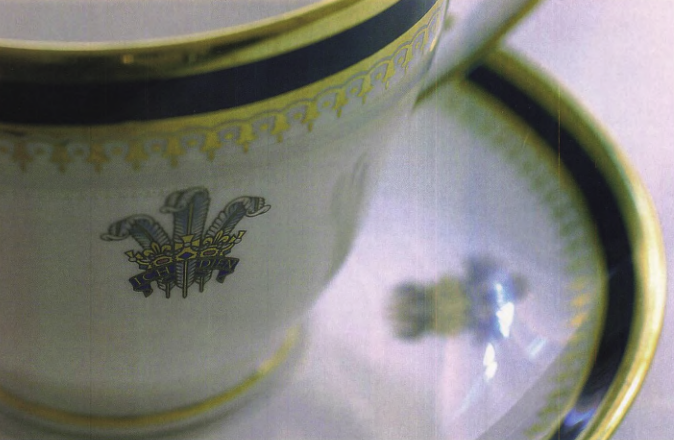
The next vehicle Chris shows us is the dining car, used to serve meals for invited guests. It can host up to 14 people, with food and drink provided from the adjacent kitchen. This is one of the greatest stores of what could be termed ‘institutional memory’ on the Royal Train. It’s always been the practice to keep crockery- and cutlery from previous Royal Trains on board, and it’s sometimes used on special occasions.
Topping the list is the 1902 set for Edward VII, which is covered in moulded gold leaf. It makes that produced for the current train look plain, and makes a marvellous talking point at dinner. Much of the time, the guests won’t sit opposite each other on the table - its narrow width means they’re more likely to sit alternating on eitherside of the table.
From the kitchen car, we move into the Household Diner, and it’s one of the few parts of the Royal Train that most people can relate to. It’s an inter-city Pullman-style coach, complete with Mk 4-style reclining seats - very like a GNER dining car, but bigger.
There’s also an audio system, with Status Quo playing as we enter - not, I am told, the usual music choice. The sound quality, though, is superb - far better than the usual scratchy public address announcements on service trains.
From the Household Diner, I’m taken into a sleeping car for household staff, which houses a room for the EWS train officer, with a lovely quote from Peter Rayner’s On and Off the Rails: “To take charge ofthe Royal Train one needs to be calm, serene and at peace with oneself.” It also houses sleeping accommodation for stewards, chefs and police officers, and these are far removed from those ofthe household staff, being standard Mk 3 berths.
Next on Chris’s tour are the Queen’s and Duke of Edinburgh’s saloons, and diis is where the restrictions mentioned earlier really come into play. All I can write about is the oversized Senior Citizens’ Railcard presented to Prince Philip on June 10 1987. That HRH decided to keep it in the train must say somediing of his sense of humour, as well as the sheer front of the BR staff who came up with the idea!
In the vestibule of the Queen’s saloon is one of the headlamps from 6233’s North Wales expedition in 2002 - a lovely touch, and one of many rail-related items in the train. The Royals are bound to have a great say in the decoration ofthe train and it speaks volumes for their regard for it that there are so many portraits of previous Royal Trains and items presented on trips. I sense they’re extremely fond of it.
Issues
The Royal Train has come in for its share of criticism in recent years, with question-marks over its cost, and the number of journeys it makes. With every penny the Royal family receives rightly under public and press scrutiny, it’s only proper that spending should be questioned, and to be fair, it’s not unknown for Royals to use service trains.
But the arguments for keeping the Royal Train go beyond costs: it has never been about providing a costeffective way oftravel. For the first century Bathrooms are fitted to some compartments. of its existence it was the fastest mode of transport, but air travel has radically altered the picture. These days, the Royal Train is much more about providing a safe and comfortable mode of transport.
But as I mentioned at the start, it’s also about making the Royal Family more accessible - word of a Royal Train visit tends to spread fast and people do go out to see it, as 2002 proved. It’s about tradition and continuity: the glue that makes society' what it is. We’ve had a Royal Train for 161 years now and it’s a direct link with Queen Victoria, and the monarchs since then.
Obviously, it’s not the same train, but the concept is exactly the same as it always was and it tells us all somediing of how this country has evolved over the past century and a half. It’s also a statement of what the railway can do at its very best.
There’s no doubt in my mind whatsoever that the current train comprises the finest vehicles of its generation, and plans to provide a new ‘train for Britain’ should be welcomed with open arms by the industry. Ours is as good as any railway anywhere, and diis is a once-in-ageneration chance to prove it to the world, even if that means funding construction and maintenance of it.
A tangible pride...
1 freely admit to being left breathless by my tour of the Royal Train. Of course the workmanship is superb and the fittings stylish, but what really hit home hardest was the almost tangible sense of pride that permeates everything at Wolverton, and the tradition of absolute perfectionism that’s required.
It’s certainly a unique experience to have seen inside it and one that’s shattered - there is no better word - many of my preconceptions.
In a sense, Chris Hillyard and his marvellous team are the guardians of a proud and unique tradition of railway excellence and it’s absolutely vital that it should be retained. This is Britain’s railway at its very, very best.
Login to continue reading
Or register with RAIL to keep up-to-date with the latest news, insight and opinion.


















Login to comment
Comments
No comments have been made yet.